
|

|
A Statistical Summary of Weapons Usage
in Sagas of Icelanders
For many reasons, we believe the Sagas of Icelanders are perhaps our best source of information about how Vikings fought and used their weapons. On this page, we've used Hurstwic's concordance of weapons and combat in the sagas to create a graphical summary of how weapons were used in the fights described in the sagas.
The data are shown in graphical form, showing how often, as a percentage of total number of instances in the sagas, any given combat usage is described. Any mention of a weapon outside of a combat context has been discarded; only combat usage has been tallied.
In some categories, there are too many different types to permit clear graphical presentation of the data. The sagas describe the use in combat of more than forty different weapons. I've combined them into eleven broader divisions. (For example, in the category of axe, I have been placed öxi, öxarhamar, viðaröxi, and many more variants.) The plot below shows the percentage of instances in which a weapon in the group is described as being used in in an attack in the sagas. As an illustration, in about 35% of the attacks described in the sagas, the weapon used is a sword.
Offensive Weapons Used in Combat in the Sagas
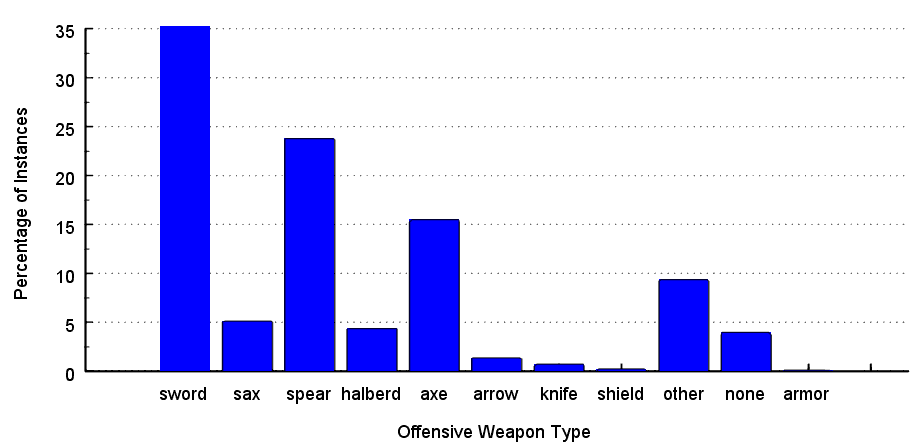
Some of the weapons described in the sagas are poorly understood today. There no known surviving specimens, and the weapons are not so well described that one can make a good guess about what they might have been. In the broader category of halberd, I've placed a number of these poorly known pole weapons such as atgeir, fleinn, kesja and others. Translators frequently use halberd for these Icelandic words, even though strictly speaking, halberd refers to a pole weapon developed and used to good effect by the Swiss in the 14th century.
The category of other includes a number of improvised weapons, such as whale bones, boat oars, anvils, stones, and the like.
Shield and armor refer to instances where shields or other defensive gear (helmet or mail) were thrown or used for striking during a fight.
None generally refers to empty hand fighting, such as grappling. This situation might occur intentionally (in a grappling-style duel, or when a fighter chose to throw away his weapons and run in to grapple). It could also occur unintentionally (such as when a weapon broke, or was thrown as a projectile, and no reserve weapon was readily available). Additionally, sometimes fighters could not draw their weapon fast enough in an ambush, so they were forced to fight empty hand.
A similar plot can be created for defensive weapons used in fights described in the sagas.
Defensive Weapons Used in Combat in the Sagas
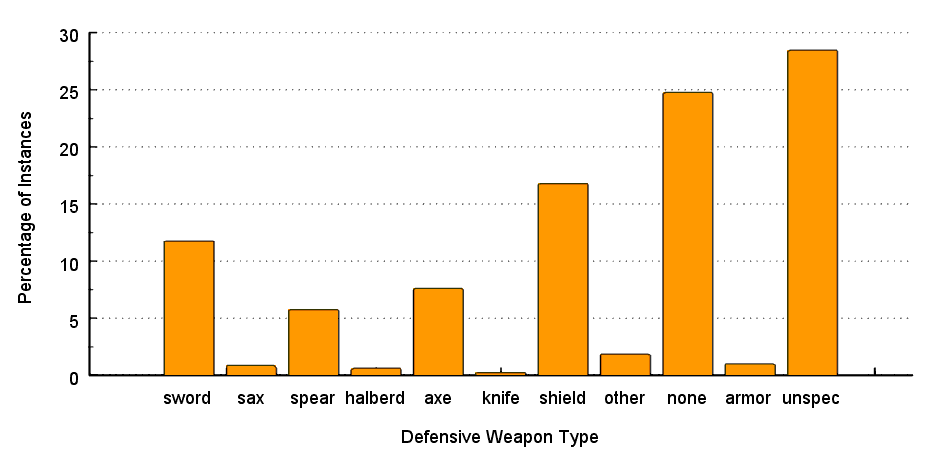
The plot shows the weapon or tool used to block (or attempt to block) the attack. If, for example, the fighter was using sword and shield, and the text clearly references the shield being used to block, that instance goes in to the shield category. A missed block that hits the helmet goes in to the armor category. In many cases, it is not possible to tell with any certainty which tool was used for defense, and those instances fall into the unspecified category.
The targets of the attacks as described in the sagas are shown in the plot below.
Combat Targets Described in the Sagas
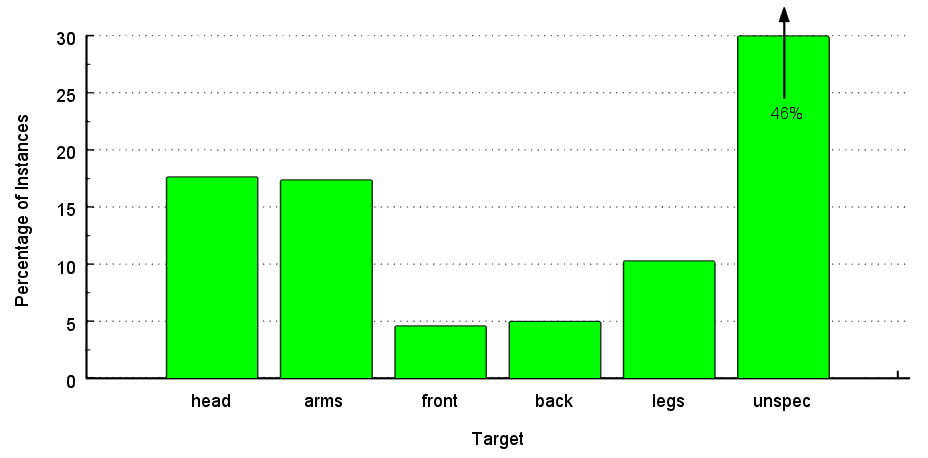
Head refers to targets from the neck up, including throat, ear, head, and others. Arms includes any portion of the upper limbs. Front includes targets above the waist, including chest, side, and stomach. Back includes backbone, and, particularly for axe attacks, blows made between the shoulder blades. Legs includes attacks below the waist, such as hips, thigh, and feet. Unspecified includes any targets that are not specifically described. For example, the saga authors often write that one fighter gave the other fighter his deathblow, without describing where the blow hit. In addition, many of the thrusting attacks fall Into this category because the saga authors often say merely that the combatant was run through. Having no further information, I categorized these attacks as unspecified. However, I believe many of these attacks were likely made to the torso and would fall into front category. The unspecified category comprises almost half of the attacks (46%) and was truncated to make it easier to read the values of other categories.
We can plot these data, divided by weapon type, to get a picture of the typical targets for each weapon.
Combat Targets Described in the Sagas Grouped by Weapon Type
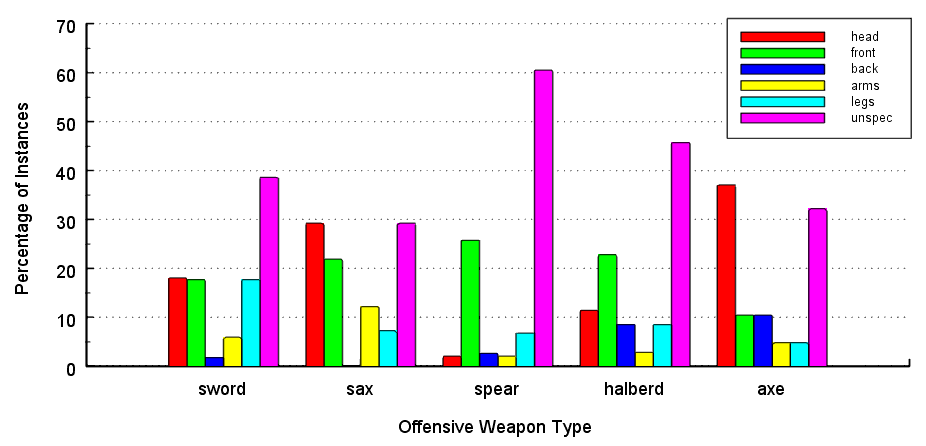

The plots show, for each weapon type, the distribution of combat targets, as described in the sagas. Again, thrusting weapons, such as the spear and halberd weapon types, have a high proportion of unspecified targets, because the saga authors frequently say only that the combatant was run through. It is very likely that many of these attacks fall into the front category.
The axe and halberd attacks have a higher percentage of attacks to the back, since the stories say that the blows from these weapons often struck between the shoulder blades. Empty hand attacks have a high percentage to the back (an attempt to break the back of one's opponent) and to the head (biting out the throat to kill an opponent, a commonly used move).
In addition to the location of the combat injuries, the sagas also describe the degree of the injury.
Combat Injuries Described in the Sagas
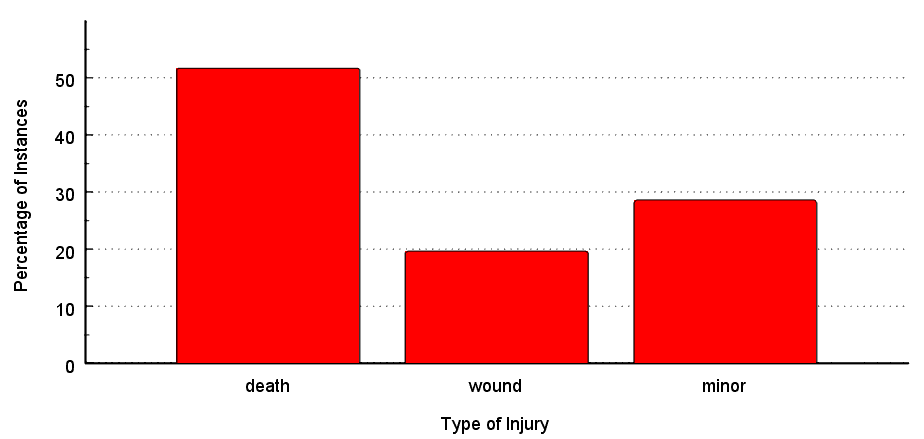
The plot shows the percentage of combat injuries described in the saga that result: in death (either immediate, or after a short period of time); in a wound (ranging from loss of limbs to bloody wounds); and in minor injuries (including instances where an attack resulted in no injury because it was successfully parried). One can imagine that a higher proportion of the attacks would result in a minor injury than is indicated by this plot. Presumably combatants in the sagas had sufficient combat skills to be able to parry many of the attacks against them. Those successful parries are likely not to have been mentioned by the saga authors. Often the text merely says that two warriors fought for a long time before the killing blow is described in detail.
Again, we can plot these data, divided by weapon type, to get a picture of the typical injuries for each weapon.
Combat Injuries Described in the Sagas Grouped by Weapon Type

The plot shows, for each weapon type, the distribution of types of injuries resulting from an attack, as described in the sagas. While these data are interesting, I was even more curious about how one weapons fares when used against another weapon. The plot above shows that a sword is lethal for 50% of the attacks described in the sagas. Is the sword. for example, less lethal when used against a man defending himself with a shield? More lethal when used against a man with no weapon?
The plot below attempts to quantify this relationship.
Lethality Of a Weapon When Used Against Another Weapon as Described in the Sagas
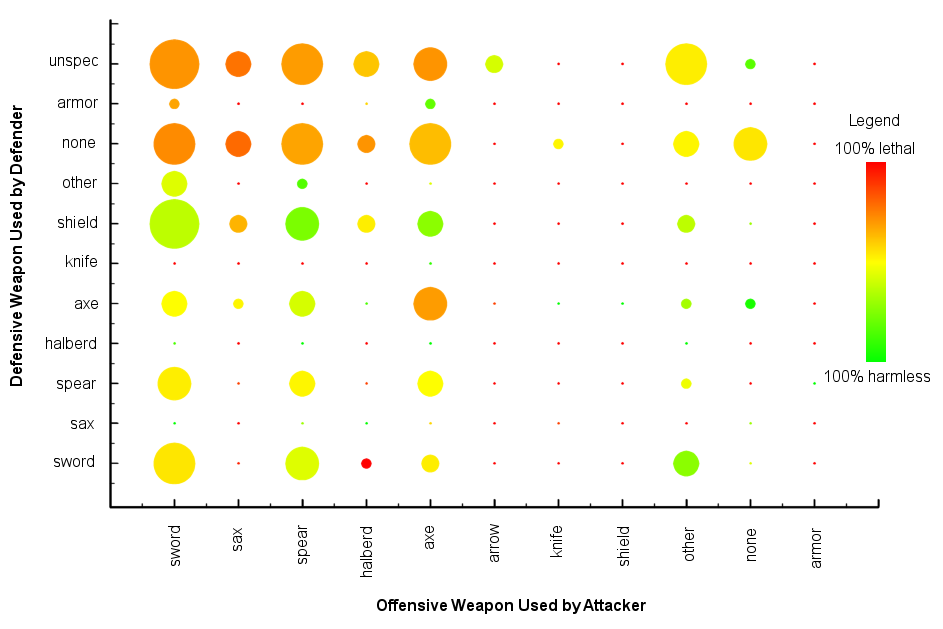
The plot shows the effect of an attack with one class of weapon against a defensive weapon of another class. The offensive weapon used in the attack is shown on the bottom, horizontal axis. The defensive weapon used to block (or attempt to block) the attack is shown on the left, vertical axis. Where the weapon types intersect is a colored circle. The color indicates how "lethal" the attack is in the instances described in the saga, with a bright red indicating it was lethal in 100% of the instances, and bright green indicating that it caused no injury in 100% of the injuries. The size of the circle gives an indication of how often this weapon matchup is described in the sagas. Small dots indicate the matchup is described rarely, and so the indicated lethality should not be taken with any confidence, since there are few examples. Large circles indicate many examples and probably represent a reliable estimate of the lethality of the matchup.
For example, when a halberd was used to attack a man with a sword, the small red circle suggests that while there were not a lot of examples, the attack resulted in a death in almost every instance. When a man with a weapon in the other category (typically an inprovised weapon) attacked a man with a sword, the medium-sized green circle tells us that the attack rarely resulted in any injury to the swordsman, and that there were many such examples in the sagas.
A few trends can be seen. A man defending with a shield generally did well against virtually all the offensive weapons, again confirming to us the value of a shield to a Viking-age fighter. A man defending with empty hand generally fared poorly, unless his opponent was also using empty hand. An axe attack blocked by armor (helmet or mail) generally was more effective at causing injury or death than a sword attack when blocked by armor.
The injuries can be grouped by target, to look for more or less vulnerable targets in combat.
Combat Injuries Described in the Sagas Grouped by Target
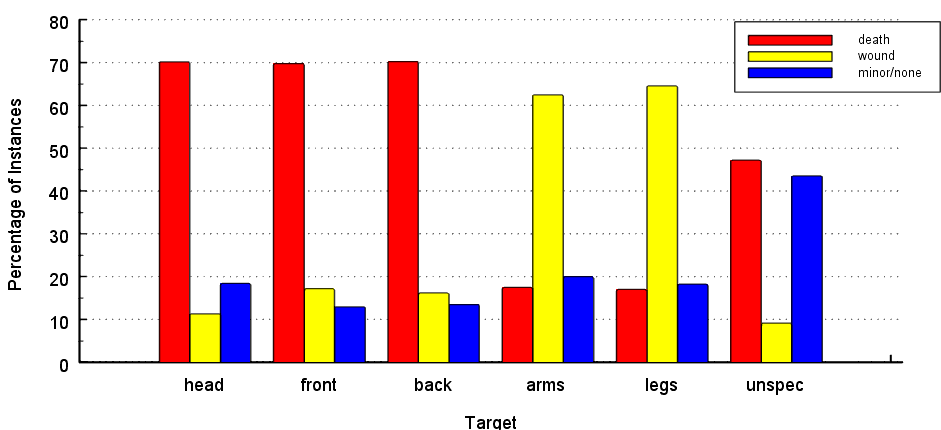
The plot shows, for each target, the distribution of types of injuries resulting from an attack, as described in the sagas. Not surprisingly, attacks to the head and torso resulted in a higher proportion of lethal injuries than did attacks to the limbs.
The attacks described in the sagas fall into the categories of cuts (which includes other blows and slices), thrusts, and missile attacks. Some attacks fall into the unspecified category, which is primarily a catchall category for attacks that couldn't be identified from the saga text.
Types of Attacks Described in the Sagas
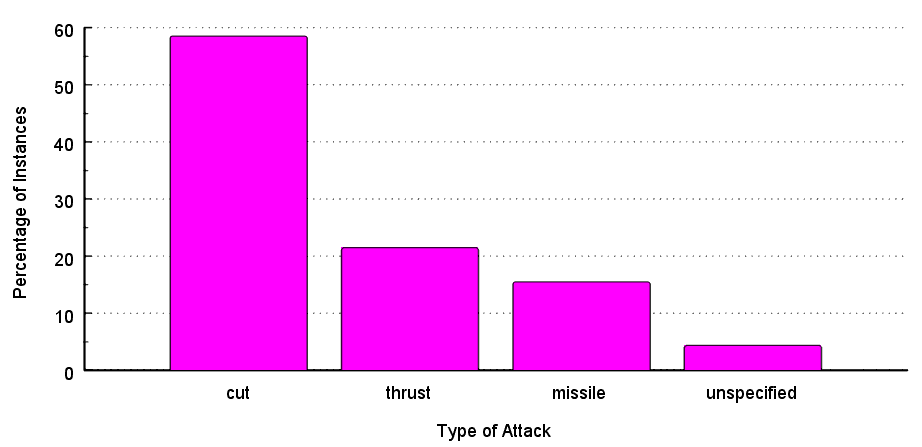
The plot above shows the percentage of instances of each kind of attack, as described in the sagas. It is possible to group these by weapons, shown in the plot below.
Attacks Described in the Sagas Grouped by Weapon Type
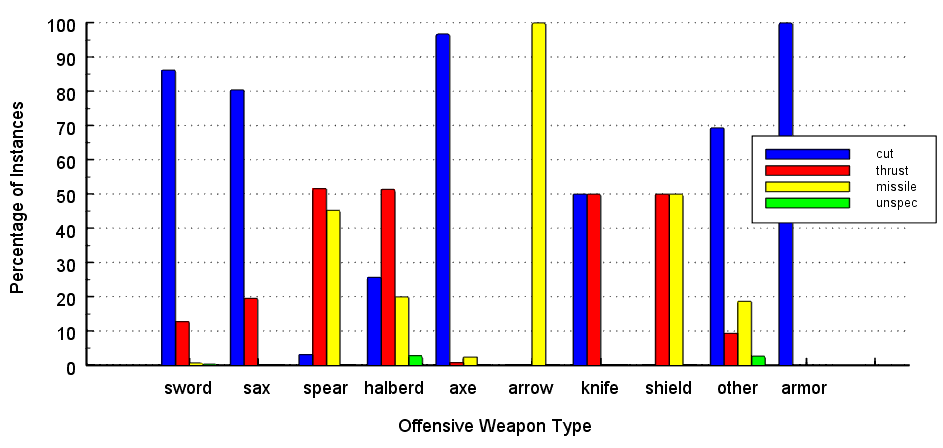
The plot shows, for each weapon type, the distribution of types of attacks, as described in the sagas, and the primary function of each weapon can be clearly seen. The axe is used for cutting. The spear is used for thrusting and throwing.
I had hoped these data might help lead to a better understanding of the halberd type weapons, which were used primarily for thrusting, but were also used in cutting attacks and missile attacks. The nature of these weapons remains elusive.
Some of the attacks described in the sagas were not meant to be lethal. Weapons were used to humiliate opponents, rather than kill them. The plot below shows the intent of the attacks described in the sagas.
Intent of the Attacks Described in the Sagas
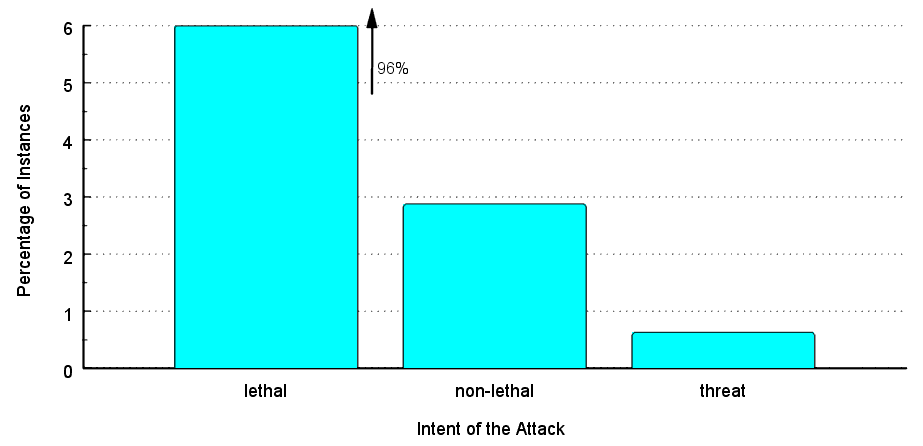
For example, the öxarhamar (the back side of the axe) was often used for a non-lethal blow whose primary purpose was to humiliate. Additionally, weapons were raised to threaten, often to emphasize a verbal threat. The intent can be grouped by weapon type, plotted below.
Combat Intent Described in the Sagas Grouped by Weapon Type
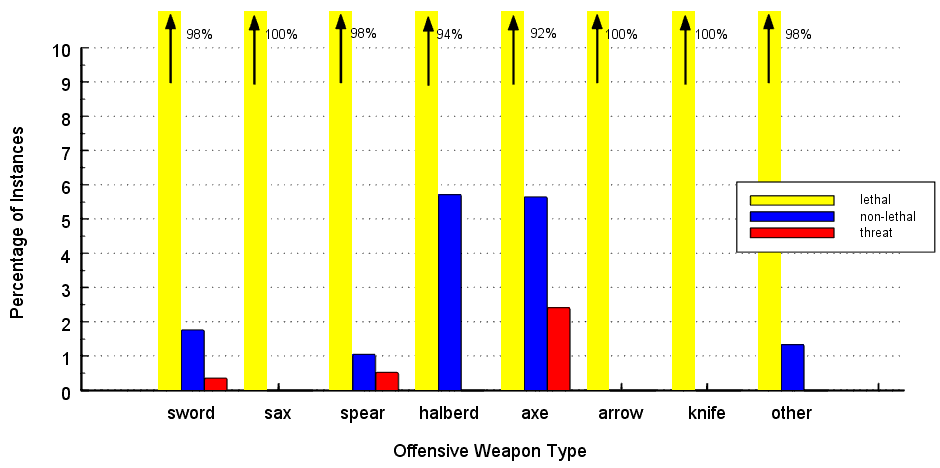
The plot shows, for each weapon type, the distribution of the intent of the weapon use, as described in the sagas. The axe type shows a higher percentage of non-lethal attacks than other weapons, in part because of attacks with the öxarhamar and because of the instances in which a verbal threat was delivered with a raised axe.
The sagas talk of different types of battles ranging from small, one-on-one fights and ambushes, to large, dynastic battles. Different weapons seem to have been preferred for different kinds of fights.
Weapons Used in Combat in the Sagas Grouped by Type of Battle
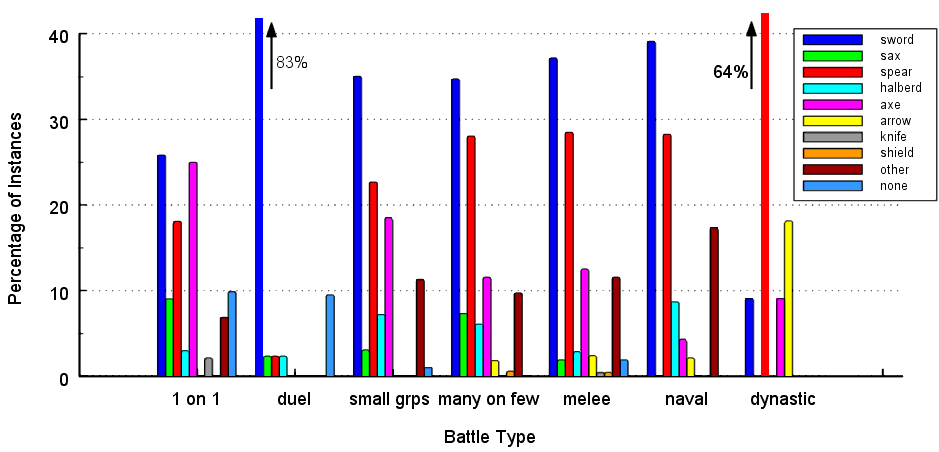
1-on-1 battles, whether planned ambushes, or by happenstance, generally used swords, spears, and axes. Duels, whether formal (hólmganga) or informal (einvígi) overwhelmingly used swords. Small group skirmishes were comprised of a few fighters on each side, while many-on-few fights had a significant imbalance in numbers, often a one or two dozen against one or two men. Melee fights had many fighters on each side. Naval battles were fought onboard ship. The tight confines onboard ship meant that fighters often picked up improvised weapons in the other category. Dyanstic battles, which in the sagas took place overseas in Scandinavia and the British Isles, had large numbers of fighters on each side. In these battles, the spear seems to have been the preferred weapon, and bow and arrow were used much more often than in other types of battles.
Weapons Used in Combat in the Sagas Grouped by Date Written
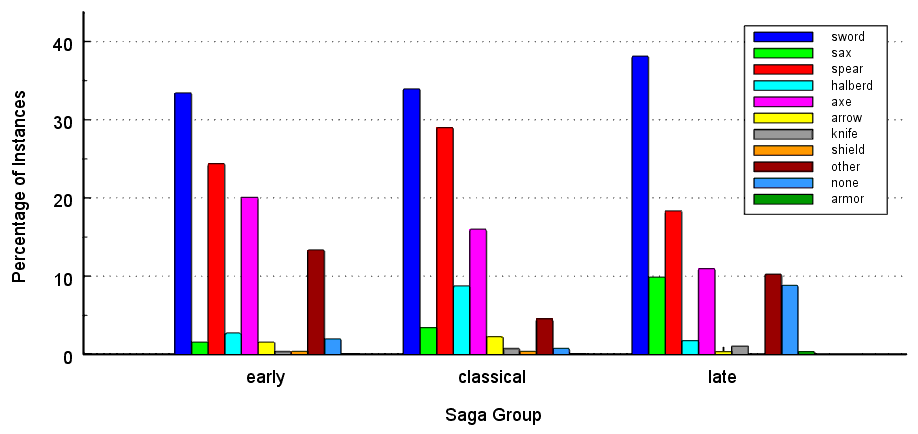
One contentious area is the matter of when the sagas were first written down. Without doubt, it wasn't until centuries after the events they describe took place. As a result, the reader has to question whether the sagas conflate the period in which they were written with the period in which they took place. Our research at Hurstwic strongly suggests that the saga authors were familiar with combat and had participated in combat, and that they were aware of the differences in weapons and techniques between their own period and the time in which the events of the sagas took place.
The plot above shows, by date the saga was written, the distribution of weapons used in combat. I've used the dating method of Vésteinn Ólason, who divides the sagas into broad categories of early, classical, and late. This plot provides less insight than I had hoped to help us test the saga authors' knowledge of Viking-age combat.
|
|
|
|
|
|
|
©2004-2026 William R. Short |